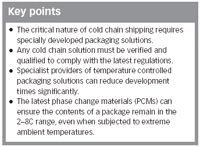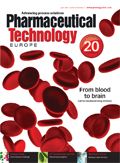Developing cold chain solutions
Pharmaceutical Technology Europe
When shipping temperature-sensitive pharmaceuticals, maintaining an unbroken cold chain is essential to ensure product integrity. Failure to do so may result in anything from a reduced shelf-life to the drugs being rendered completely useless, which means significant costs. If the products are being shipped for clinical trial purposes, the losses can be even greater, as the cost of R&D of a new drug is at stake — which was recently estimated to be $800 million (€550 million).1 This critical nature of cold chain shipping is driving new levels of investment in controlled packaging solutions that have been developed to protect pharmaceuticals that are shipped by land, air or sea — often through extreme and varying temperatures.

When specifying a temperature-controlled packaging solution, an organization must choose between an off-the-shelf solution or a bespoke system tailored. The decision largely depends on the value of the products to be shipped, and the potential repercussions of the drugs straying outside their acceptable temperature range. Whatever the choice, any system must be verified and qualified to ensure the likelihood of success, and to bring the packaging up to date with the latest guidelines and regulations.
These guidelines are provided by various independent institutions such as the Parental Drug Association (PDA), a leading provider of information and education for the pharmaceutical and biopharmaceutical community. PDA recently updated its technical report on best practices for developing, validating and qualifying temperature-controlled packaging systems to offer more detailed advice on shipping goods globally, recognizing the extended distances and durations now being covered.2

Key points
Test for success
With the level of technical knowledge and resources required to develop a controlled packaging solution that can adequately protect temperature sensitive drugs, manufacturers and clinical research organizations (CROs) are increasingly working with specialist providers of packaging solutions. Whether a prequalified system is chosen or a brief given to develop a bespoke solution, a number of processes should be performed to ensure the correct system is chosen.
Typically, the packaging specialist will initiate the design and testing process by providing a detailed needs assessment form that covers:
- project description
- project scope
- deliverables
- schedule
- product description
- transit medium
- duration required
- threshold temperature
- ambient temperature ranges
- product stability
- logging
- container type.
These criteria are essential to finding or developing a solution meets the pharmaceutical organization's technical and commercial objectives.
Once the initial client research is complete, project development and design analysis can begin. Software modelling programmes and mathematical models are used to begin a preliminary analysis and to develop the thermal solution. Sometimes, a degree of prequalification may be achievable, based on the specialist's knowledge and experience gleaned from previous projects or by using off-the-shelf packaging solutions.
During this process, communication between customer and supplier is essential to ensure that the needs of the solution are fully understood. Usually, designs are revised and refined through a number of permutations. Testing chambers improve the designs by subjecting the proposed package to likely temperature ranges to come into contact with in real life applications. By thermally mapping the payload volume, it is possible to identify high and low temperature points to ensure the product's thermal variations are controlled at all times.
For any temperature-controlled packaging system, qualification testing is necessary to guarantee the proposed solution and shipping procedures will be able to protect the products being distributed under the conditions expected. It is important to document this testing as reports are likely to be required during shipment to prove the solution used is qualified. These reports contain information such as verification of the testing parameters used; performance results; data acquisition location diagrams for each test performed; and, importantly, dated signatures from both the author and approver.
Sophisticated materials
Developing a temperature-controlled packaging system that can protect pharmaceuticals for the long distances involved in global shipping is achievable largely because of the development of sophisticated phase change materials (PCMs). In many cases, these materials have replaced conventional solutions to ensure the contents of a package remain in the 2–8 °C range, even when subjected to extreme changes in the ambient temperature.
Traditionally, the temperature of products was maintained using frozen or chilled pouches of water combined with insulating liners in cardboard outer cartons. Although this method of temperature control can still be viable, it is unsuitable for the demands of the pharmaceuticals industry because of the valuable and sensitive nature of the items being transported.
By contrast, PCMs can maintain a desired temperature within specially designed packaging because they absorb or release large amounts of heat energy as they move from one state, or phase, to another. Unlike water (which is a simple type of PCM) changing phase (into ice) at 0 °C regardless of the requirements of the contents of the package, the latest sophisticated PCMs consist of specially developed hydrated salt or paraffin solutions, and are designed to change phase at specified temperatures.
This technology simplifies distribution processes; for example, allowing packages to be placed in a chiller en route to their destination while maintaining the desired temperature. It offers a significant benefit to pharmaceutical organizations, enabling them to retain control of the conditions surrounding their products after they have been passed to a third party distributor.
Similarly, specially designed PCM solutions can keep drugs frozen at -15 °C, offering a better alternative to traditional dry ice solutions. Carbon dioxide, the gas used in dry ice, is a greenhouse gas and has been classified under the dangerous goods regulations for transportation,3 leading to restrictions on the quantity allowed on airlines, and escalating costs where freight premiums apply. Furthermore, dry ice absorbs heat at -80 °C, making it too cold for shipping some delicate products. It can also damage the rubber bungs used to seal primary packaging or cause a drug to lose its sterility because of migration of carbon dioxide.
Recent developments in PCMs are not limited to cold chain distribution; many CROs use the latest PCMs that have been specifically developed to provide temperature stability for 15–25 °C; 15–30 °C; or 20–24 °C. This technology is able to maintain a constant temperature for more than 100 h, compared with 12 h for conventional solutions.
Keeping watch
One major benefit of the latest PCMs is their ability to be re-used, which minimizes the cost of cold chain distribution and reduces waste.
To maximize the efficiency of the technology, it is often used with re-usable insulating containers to create an effective return-to-base solution. This ensures that products reach their destination in the best possible condition during a 3-year working life of the shipper. These shippers can also be colour-coded to reduce logistical errors.
Once an effective solution has been developed, it is important to maintain communication with the packaging specialists, as they can review real life results to ensure the solution is behaving as expected. If necessary, they can also refine the design. Information regarding the condition of a drug during transport, such as the average temperature of the inside of the package; the highest and lowest temperature recorded; and any time spent outside of the preset high and low limits, can be recorded and analysed using specially designed data logging technology. Small data loggers placed inside packages provide an accurate record of the temperature during the product's journey, with an accuracy to 0.5 °C, and in ambient temperatures ranging from -30 °C to 70 °C. When the package reaches its destination, the information can be downloaded to a PC to give a detailed temperature history, which can then be analysed. The devices also feature integrated alarms, which sound if the temperature inside a package exceeds or approaches minimum or maximum tolerances, enabling action to be taken quickly and preventing entire shipments of medicines or vaccines from being wasted as a result.
In summary
Temperature-sensitive pharmaceuticals are being transported longer distances than ever before, and the need to ensure the reliability of the cold chain is essential. This can only be achieved by investing a significant amount of time, resources and money into designing, testing and producing a controlled packaging solution that meets the requirements of the application. By using the latest PCMs, and working with a temperature-controlled packaging specialist, a reliable solution can be found quickly and cost-effectively, minimizing the risks associated with shipping temperature-sensitive drugs.
Geraint Thomas graduated from Brunel University in 1996 with a BSc (Hons) in industrial product design. After working as a board bame engineer for Hasbro toys, Geraint joined Laminar Medica (UK) in 1998 as a packaging development technologist with responsibility for packaging solutions and qualification packages for insulated shipper design. Now employed as technical director, Geraint has been instrumental in realizing Laminar Medica's development programme, including the expansion of the company's qualification laboratory and R&D facility.
References
1. J.A. DiMasi, R.W. Hansen and H.G. Grabowski, Journal of Health Economics, 22(2), 151–185 (2003).
2. Parental Drug Association, "Guidance for Temperature Controlled Medical Products: Maintaining the Quality of Temperature-Sensitive Medicinal Products through the Transportation Environment", Technical Report Number 39, (2007).
3. United Nations Economic Commissions for Europe — Recommendations on the Transport of Dangerous Goods, August 2007.

Drug Solutions Podcast: A Closer Look at mRNA in Oncology and Vaccines
April 30th 2024In this episode fo the Drug Solutions Podcast, etherna’s vice-president of Technology and Innovation, Stefaan De Koker, discusses the merits and challenges of using mRNA as the foundation for therapeutics in oncology as well as for vaccines.